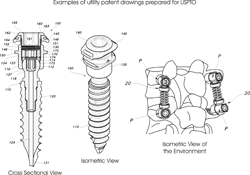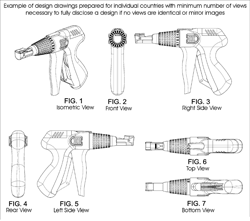
Better Drawings Make a Better Patent
By Bernadette Marshall
This article is by Bernadette Marshall, President, NB Graphics & Associates, Inc. Ms. Marshall heads a creative team, specializing in the preparation of design and utility patent drawings and trademark illustrations. She and her team have over 20 years of experience working nationally and internationally.
“A picture speaks a thousand words.” That ancient adage certainly holds true in the case of patent drawings. An invention can often be more easily explained through drawings than in reams of description. Accurate, clear drawings strengthen and enhance patent applications, helping overloaded patent examiners to understand inventions faster.
Simple, clear and precise images also help to instruct judges in cases of patent infringement, often clarifying the patent owners’ claims and clinching the decision in their favor. Drawings can also work to the advantage of patent holders in negotiating damages or a settlement. Even more important, meticulously prepared drawings that make the patent understandable and unambiguous may mean potential infringers will think twice about copying. The earlier infringement is deterred the better it is for patent owners.
Patent filers should not underestimate the importance of drawings in their applications. Patent offices apply specific criteria concerning the technical details of drawings they accept, but attention must be paid to more than just meeting those requirements. A patent applicant’s safest option is to use the services of a professional draftsperson specialized in technical patent drawings and knowledgeable of the various demands of patent offices.
Technical specifications
Many patent offices now accept drawings submitted on anything from paper to digital media, but specifications on shape, size and form often vary. For example, for filings on paper, some patent offices require that flexible sheets be used while others specify rigid cardboard. Beyond the media itself, there can also be significant differences in the drawing specifications when it comes to, for example, surface shading, broken lines and line thickness.
Drawings must meet the requirements of (a) the country where the patent is filed, (b) the U.S. Patent and Trademark Office (USPTO), for filings in the U.S. and (c) the Patent Cooperation Treaty (PCT) for international applications. The PCT specifies how patent drawings are to be created and submitted in its 142 contracting states.
Some requirements are universal to all patent offices: drawings must be clear, in black and white and have solid black lines. The main difference between drawings for the USPTO and PCT filings, for example, is the size of the paper on which drawings can be submitted. The USPTO allows letter size paper or A4, while the PCT only accepts size A4. Margins remain the same whether filings are done on A4 or letter size pages.
| PCT drawings |
|---|
|
The PCT only requires drawings where they are necessary for the understanding of the invention. This will be the case for a mechanical or electrical invention. It will not be the case when an invention cannot be drawn, as is the case for a chemical product. In each of the drawing figures, reference signs or numerals for the various elements in the drawings are to be provided, and corresponding explanations of their function and operation included in the description. |
Utility patents
There are strict requirements for drawings of utility patents. They should be prepared in the correct scale ensuring that lines, numbers and letters are “sufficiently dense and dark and uniformly thick and well defined” – enough to give them “satisfactory reproduction characteristics.” Depending on the invention, tables, chemical or mathematical formulae, waveforms of electrical signals and symbols can also be used.
Drawings or diagrams are usually crafted to correspond to the individual claims of the patent. Specific views may be used to illustrate a problem the invention solves, a particular advantage it offers or a need it fulfills, thereby describing a new function or how the invention implements that function. Prior art can be used to show contrast or to differentiate a new invention from an older one or, for a new invention consisting of an improvement to an existing one, the drawings can show the improved portion with enough of the old invention to demonstrate the connection.
Placing an invention in its intended environment can make it more easily understandable, and the drawings themselves can be arranged in such a way that it helps readers to better understand the invention. Plan or elevated views, perspective views, isometric projections, sectional views and exploded views can be used as well.
The more complex and hard to define the invention, the more valuable the draftsperson’s suggestions for improving the drawings and presenting the invention clearly will be. If drawings are created before the patent application is completed, the applicant can save time by basing the detailed description on the sequence of drawings.

Diagrams: Courtesy NB Graphics & Associates
Design patents
Unlike utility patents, applications for design patents rely fully on the drawings. According to USPTO guidelines, “the drawing disclosure is the most important element of the application,” and the drawings in design patent applications “constitute the entire visual disclosure of the claim.” In well-executed drawings “nothing regarding the design sought to be patented is left to conjecture.”
Most countries include similar rules in their guidelines. One notable difference, however, is that the USPTO requires all surfaces of drawings to be appropriately and adequately shaded: “Shading which shows clearly the character and contour of all surfaces of any three-dimensional aspect of the design.” This requirement makes USPTO design drawings appear more artistic than those of most other countries that more closely resemble engineering or technical drawings (but without the dimensions) as they do not include shading or broken lines. Design drawings with surface shading and broken lines are acceptable under the PCT.
Most countries require a number of views, executed as black-and-white line art, sufficient to fully disclose the invention. If the design cannot be shown by line art, photographs may usually be submitted instead. In cases where photographs are not allowed and an applicant is requested to supply regulation black-and-white drawings, the applicant will not be allowed to correct any inconsistencies in the drawings once they have been submitted, unless that can be done without adding new matter. Nothing can be removed or added when replacing figures. The USPTO specifies, “An incomplete or poorly prepared drawing may result in a fatally defective disclosure which cannot become a patent.”

Generating photographs or drawings for design patents that depict exact views can be challenging. For instance, only one side of the invention may be shown per photograph or drawing. For a simple cube, for example, each photograph or drawing should show only one side – not the side and a portion of the top or of another side. When using photographs as a reference for drawings, any distortion in them must be corrected.
Informal vs. formal drawings
In the case of filings containing informal drawings, the images are converted – through copying – into poor quality images. This process causes them to lose integrity, quality and detail. When the patent office requests that the applicant submit formal drawings, often the only existing reference material is a low quality copy of the informal drawing. When such material is all a draftsperson has to go on, it takes longer to execute the formal drawings and results in more revisions, increasing costs for the applicant.
Design patents can only be corrected if no new matter is introduced. So applicants who submit informal drawings with inconsistencies may find themselves caught in a proverbial “Catch 22” situation: either the drawings will be rejected for being inconsistent or because new matter has been added.
Finding a good draftsperson
Generating good drawings requires technical skill and creativity. There is no special license or university degree for patent drafting. A draftsperson’s experience, body of work, professional references and use of technology are good indicators of competence and skill.
Most are skilled in computer-aided design and drafting (CADD) and have gained experience under the supervision of senior professionals. Firms often employ several draftspersons, providing a broad skill set as well as a variety of perspectives and approaches. Expertise must be acquired through years of practice, for which there is no easy substitute.
Computer vs. hand-drawn figures
It is not the quality of the equipment but the skill of the draftsperson that is important, and there is nothing wrong with traditional hand-drawn figures. However, the most cost-effective process is to make drawings from CADD files, which avoids the draftsperson having to recreate the drawings from scratch. For items that have already been manufactured or for existing prototypes, chances are there are CADD files available as they are used in all modern manufacturing processes.
Where that is not the case, creating drawings in CADD has its advantages. Electronic data can be archived to simplify the subsequent amendment of drawings; drawings can be modified to create new drawings; and duplicate elements in a drawing can be copied and reused instead of having to redraw each one manually.
Choose the best
The patent drawings in an application may be accepted in one country and rejected in another. But regardless of where an applicant files, good drawings make for good applications – and for a good defense when necessary. Once good, accurate and clear drawings are executed, the patent applicant has only one difficult choice to make: selecting the best one for the front page of the application.
The WIPO Magazine is intended to help broaden public understanding of intellectual property and of WIPO’s work, and is not an official document of WIPO. The designations employed and the presentation of material throughout this publication do not imply the expression of any opinion whatsoever on the part of WIPO concerning the legal status of any country, territory or area or of its authorities, or concerning the delimitation of its frontiers or boundaries. This publication is not intended to reflect the views of the Member States or the WIPO Secretariat. The mention of specific companies or products of manufacturers does not imply that they are endorsed or recommended by WIPO in preference to others of a similar nature that are not mentioned.